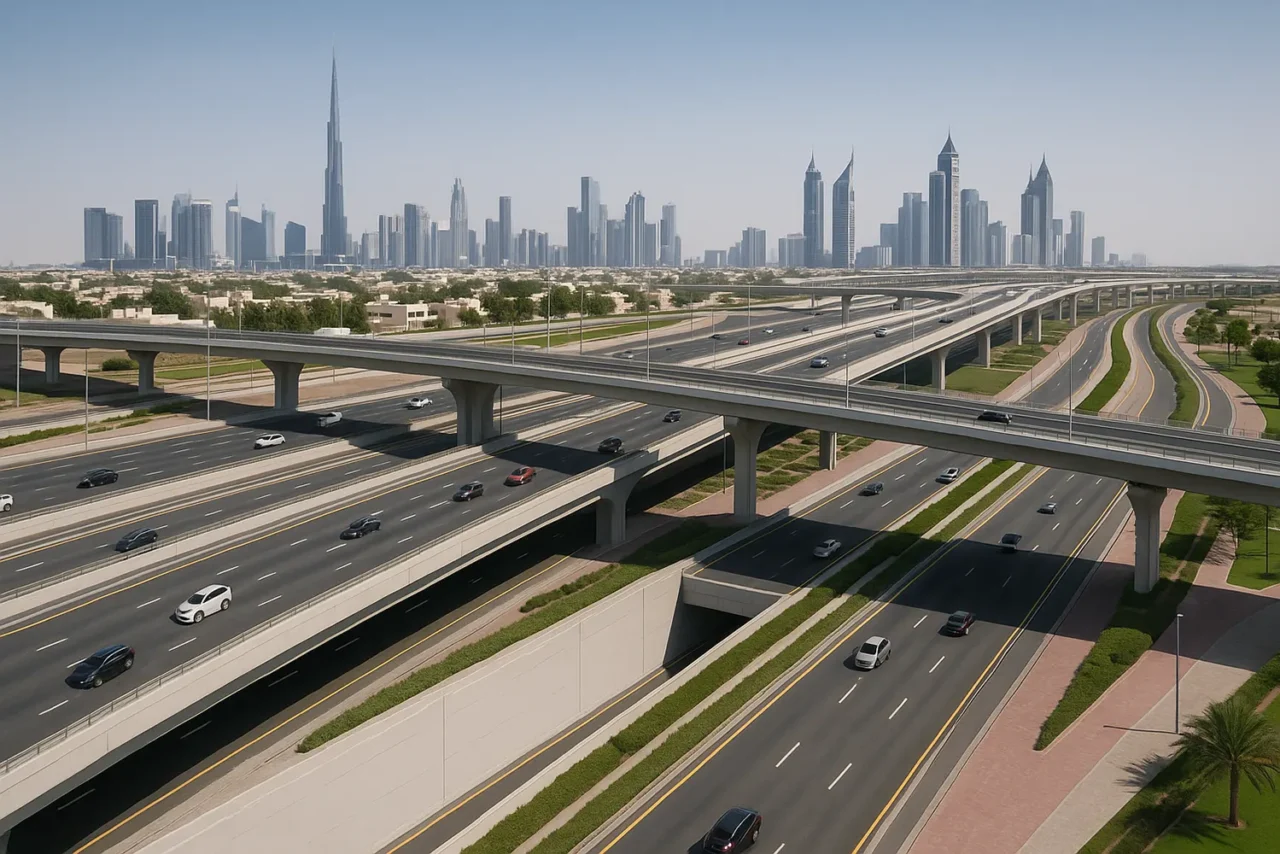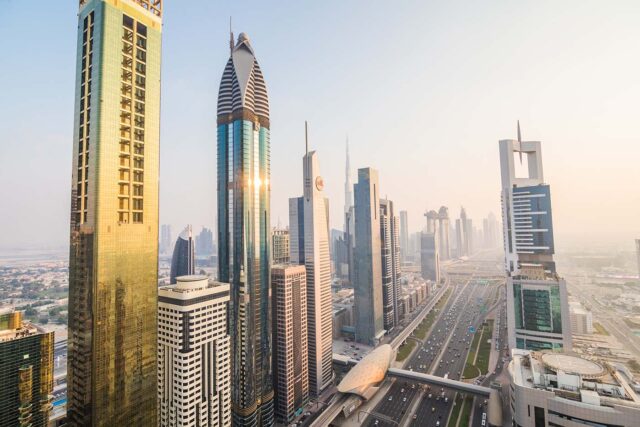
Dubai’s Roads and Transport Authority (RTA) is moving ahead with a major 2025 road infrastructure upgrade along Umm Suqeim Street, as part of a longer Umm Suqeim–Al Qudra corridor. The project will extend from Jumeirah Street in the west to Emirates Road in the east (about 20 km total), linking a series of important suburbs and highways. RTA says the upgrades will expand Umm Suqeim Street’s capacity to 16,000 vehicles per hour in each direction, and slash travel times dramatically. For example, trips between Jumeirah Street and Al Khail Road are expected to fall from 20 minutes to just 6 minutes. This new corridor will connect key east–west routes and improve integration with the four major north–south highways (Sheikh Zayed Road, Al Khail Road, Sheikh Mohammed bin Zayed Road, Emirates Road). By linking residential and business areas from Jumeirah to Al Qudra, the scheme supports Dubai’s long-term growth and the 2040 Urban Master Plan.
Project Scope and Highlights
The Umm Suqeim corridor upgrade is a comprehensive infrastructure development, not just widening a road. It includes six major intersections and will create an uninterrupted east–west route from Jumeirah Street to Emirates Road (Al Qudra Road). Key highlights include:
- Corridor Length: ~16 km from Jumeirah Street to Emirates Road, traversing Jumeirah, Al Manara, Umm Suqeim, Al Barsha and beyond. This forms part of a 20 km east–west corridor linking the coast to Al Qudra Road.
- Vehicle Capacity: Up to 16,000 vehicles/hour per direction. Doubling lanes in key stretches will boost capacity.
- Travel-Time Cuts: Projected journey times will drop by up to 61%. For example, the segment between Sheikh Mohammed bin Zayed Road and Al Khail Road will fall from 9.7 min to about 3.8 min. The western segment (Jumeirah St to Al Khail Rd) will go from ~20 min down to ~6 min.
- Key Intersections (6): Jumeirah Street, Al Wasl Street, Sheikh Zayed Road, First Al Khail Street, Al Asayel Street and Al Khail Road. Each intersection is being reconfigured with new grade separations and signal improvements.
- Bridges and Tunnels: Construction of 4 new bridges and 3 tunnels (total ~4.1 km in length) is planned. Major structures include an 800-m tunnel (4 lanes each way) at Al Barsha South near Kings’ School, two new bridges over Sheikh Zayed Road, and underpasses at Jumeirah and Al Wasl streets.
- Multi-Modal Facilities: The design integrates pedestrian walkways, dedicated cycling tracks, landscaped boulevards and urban plazas. It also creates a direct pedestrian link between the Mall of the Emirates Metro Station and nearby neighbourhoods, aligning with Dubai’s push for transit-oriented development.
Major Engineering Features
The intersection upgrades involve extensive civil works. RTA notes that six junctions will be transformed with separate structures to eliminate traffic conflicts. For example: at Jumeirah Street, a new two-lane tunnel will carry Umm Suqeim traffic beneath the intersection (along with a surface-level signalised junction). Similarly, Al Wasl Street will get a two-lane underpass to allow flows from Sheikh Zayed Road toward Jumeirah without disrupting through traffic. At Sheikh Zayed Road, two new bridges will span the highway to separate crossing movements. Near Kings’ School in Al Barsha South (along First Al Khail Street), RTA is building an 800-m tunnel with four lanes each way to carry Umm Suqeim traffic under Al Barsha, plus a signalised intersection at surface level. At the Al Khail Road end, two flyovers will be built – one connecting Al Khail Road to Al Quoz Industrial Area, and another linking Umm Suqeim Street to Al Khail Road toward Deira. In between, the road is being widened (e.g. adding one lane each way between First Al Khail and Al Asayel) to create four lanes per direction on key stretches.
Key Engineering Highlights: Six upgraded intersections (Jumeirah, Al Wasl, SZR, First Al Khail, Al Asayel, Al Khail) with new structures; 4 bridges and 3 tunnels (~4.1 km total); e.g. 800m four-lane tunnel at Al Barsha South; two bridges over Sheikh Zayed Road. Pedestrian/cycling paths and landscaped boulevards are also included.
Traffic and Connectivity Benefits
When complete, the upgraded corridor will become a high-capacity east–west artery across Dubai. RTA expects traffic flow to improve dramatically: travel time on the corridor from Sheikh Mohammed bin Zayed Road to Al Khail Road will be cut by 61% (from 9.7 to 3.8 minutes). Similarly, journeys between Jumeirah Street (near the coast) and Al Khail Road will shrink from 20 minutes to about 6 minutes. This is achieved by segregating flows at intersections and removing signal delays. The overall network connectivity also gains: Umm Suqeim Street will link seamlessly to four strategic corridors (SZR, Al Khail, Sheikh Mohammed bin Zayed, Emirates), creating new direct routes across the city. In practical terms, residents from Umm Suqeim, Al Manara, Al Sufouh, Al Barsha and Al Quoz – collectively over two million people – will benefit from quicker commutes and less congestion. For example, traffic coming from Al Barsha into the corridor will use the new Al Barsha South tunnel instead of congested surface roads. The project therefore provides a true “greenfield” east–west link complementing the existing north–south highways.
Construction Progress and Timeline
Construction is already well under way. As of May 2025, RTA reports that about 70% of the initial phase (the 4.6 km section from Al Khail Road to Sheikh Mohammed bin Zayed Road) is complete. This phase includes the Al Barsha South tunnel and related works. The RTA expects to open this segment in third quarter 2025. At the same time, a second project is upgrading Al Qudra Road (part of the same corridor) from Sheikh Mohammed bin Zayed Road to Emirates Road. On Al Qudra Road, RTA is building 2.7 km of new bridges and widening 11.6 km of roadway, which will raise capacity and cut travel time from 9.4 minutes to just 2.8 minutes. This includes a 600-m four-lane bridge at the Arabian Ranches/Dubai Studio City intersection and two major 700–900 m bridges at Sheikh Zayed bin Hamdan Street. Service roads (3 km) are also being added alongside Sheikh Zayed bin Hamdan Street. In summary, RTA’s phased approach means travelers will see incremental benefits: the Al Khail–MBZ segment opens later in 2025, followed by the full Umm Suqeim and Al Qudra corridor enhancements in the subsequent years.
Neighborhoods and the 2040 Vision
The upgrades directly serve Dubai’s strategic neighborhoods. Coastal areas like Jumeirah and Umm Suqeim (with hotels and villas) get faster links to SZR and Al Khail Road. Central communities such as Al Barsha, Dubai Hills and Al Quoz (industrial and mixed-use zones) gain from the new underpasses and intersections. Even suburban and desert developments around Al Qudra, Arabian Ranches and Dubai Studio City benefit via the Al Qudra Road project (faster access to Al Qudra Road and SZR). By integrating a dedicated cycling track and improved pedestrian access, the project dovetails with Dubai’s “20-minute city” principle – one of the pillars of the 2040 Urban Master Plan. This plan calls for mixed-use urban centers where most daily needs are reachable within 20 minutes by foot, bike or public transit. In line with that vision, the Umm Suqeim corridor will directly link the Mall of the Emirates Metro Station to nearby housing, schools and offices, promoting multi-modal mobility. The TOD (transit-oriented development) initiatives in Dubai emphasize such connectivity, and this project is a clear example. In fact, in a recent planning meeting RTA’s leadership explicitly connected such projects to the 2040 plan and the 20‑minute city agenda.
Economic Impact and Investor Opportunity
Robust road infrastructure underpins economic growth and property value. Studies and market analysts observe that better connectivity makes neighborhoods more attractive, driving up demand and real estate prices. In Dubai, recent developments (metro expansions, new highways) have historically sparked price gains in adjacent areas. For example, areas near new Metro lines saw double-digit gains in the years following launch. The Umm Suqeim and Al Qudra corridor projects signal to investors that Dubai is committed to long-term infrastructure. Such large-scale RTA Dubai projects enhance the city’s economic competitiveness – they reduce delays, lower business costs, and improve quality of life. From an investment perspective, the saying “invest in Dubai roads” holds true in spirit: government capital on roads often translates into better returns on properties and businesses along those routes. In practical terms, this means developers and property owners in Jumeirah, Al Barsha, Al Quoz and even Al Qudra can expect a boost in locational value.
For international and UAE investors alike, the message is clear: Dubai’s 2025 road upgrades are not merely traffic projects, but strategic drivers of urban development. They support Dubai’s vision to become a more sustainable, liveable city by 2040, and they help spread economic activity across multiple centers. As travel becomes quicker and more reliable, areas once peripheral can become prime investment targets. In short, the Umm Suqeim corridor upgrade – with its bridges, tunnels, and green transit links – exemplifies how Dubai’s infrastructure development fuels property markets and business opportunities.




Leave a Reply